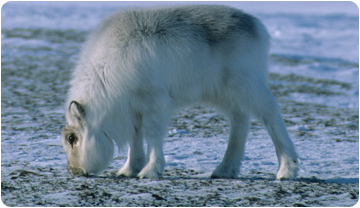
Reconstruction of a dinosaur from the Catalan pre-Pyrenees, about 70 milion years ago. Oscar Sanisidro. ICP The journal Nature has published a study analysing the lines of arrested growth (LAG) in the bones of around a hundred ruminants, representative of the specific and ecological diversity of that group of mammals. The results show that the presence of these lines is not an indicator of an ectothermic physiology (does not generate internal heat), as had previously been thought, since all warm-blooded mammals have them. The study therefore dismantles the key argument of the hypothesis that dinosaurs could have been cold-blooded reptiles. The work was carried out by researchers from the Institut Català de Paleontologia Miquel Crusafont (ICP), in collaboration with a researcher from the Norwegian Polar Institute. 
Alpine red deer; slide showing two double rest lines in the inner cortex and an external fundamental system (EFS) at the outer bone surface. Meike Köhler. ICP LAGs are seen in bone sections as dark rings, similar to those seen in tree trunks. The rings are formed, both in the studied mammals and in trees, during the unfavourable seasons (winter or dry season) when the growth of the organism is arrested as a result of a lack of resources. The presence of LAGs in bones was, until now, considered to be the clearest indicator of ectothermy since the seasonal arrest of growth was related to the animal's inability to maintain a more or less constant body temperature (endothermy) during the season of scarce resources. As the ICREA researcher and ICP palaeontologist Meike Köhler explains: The study we have carried out is very powerful, both in terms of the amount of material and the diversity of species with which we worked, but we did not design it to find a response to the thermophysiology of dinosaurs. We sought to better understand the physiology of extant mammals and how the environment affects them – how their growth changes as a result of external temperatures, rain and the availability of food and water. Understanding this was the first step to establishing discussions in paleontological research about the physiology of animals that lived several million years ago. 
Climatic context of rest line formation. Selection of African and European localities covering the principal Köppen–Geiger climate zones, organized into Northern Hemisphere and Southern Hemisphere. The NH and SH models summarize the patterns for the Northern Hemisphere and the Southern Hemisphere. The emerging pattern of seasonality of growth and growth arrest is compelling despite a data gap caused by the timing of hunting seasons. Meike Köhler. ICP But the researchers realised that what they observed in the bones of different ruminants refutes the main argument for an ectothermic physiology in dinosaurs. Many hypotheses set out from the premise that large mammals – endothermic par excellence – do not have LAGs in their hard tissues since they do not need to arrest their growth responding to external temperature conditions. In fact, since LAGs have been observed in almost all species of dinosaur, many scientists considered that they were cold-blooded reptiles. The article published today in Nature offers the first systematic study, based on an extensive sample of mammals representative of a large variety of ecosystems, which shows that LAGs do not indicate an ectothermic physiology but give us information about how the physiology (metabolism) of an animal changes according to seasonal endocrinal changes, both in cold- and warm-blooded animals. These changes represent a common heritage in all vertebrates and are a kind of internal clock that regulates the animals’ needs according to the seasonal availability of resources. Despite the fact that these physiological changes have a strong genetic component, they are also functional and their intensity depends on the ecological conditions in which the animals live. The main ecological factors are more rain and limited supply of food and water, rather than external temperature. This discovery opens up a major line of research into the conservation of biodiversity on our planet today. 
Svalbard reindeer, one of the studied ruminants. A nine month old male searching for food during late winter at the high-arctic Spitzbergen, Svalbard. Ronny Aanes. Institut Polar de Noruega Researcher Meike Köhler says: It may seem surprising that until now there has not been a similar systematic study to prove or disprove whether it is only ectotherms that leave these marks in their bones during growth. In fact, there are so many things we do not know that science does not always advance in a linear way. The ideas somehow had long been wandering among the scientific community, but the work we have published organizes them and bases them on data. In fact, some previous studies had already questioned this hypothesis and among the international scientific community there has been increasing consensus about the idea that LAGs were not necessarily indicators of ectothermy. Similarly, examples of mammals that seemed to have LAGs in their bones had emerged. This study conclusively closes the debate. The ICP researchers Xavier Jordana, lecturer of postgraduate studies at the Universitat Autònoma de Barcelona and Nekane Marín, PhD student at the same university, have also participated in this study. Ronny Aanes from the Norwegian Polar Institute and currently at the Centre for Conservation Biology (CCB) of the Norwegian University of Science and Technology is the fourth author of this paper. + info Meike Köhler, Nekane Marin, Xavier Jordana & Ronny Aanes. (published online, 2012). Seasonal Bone Growth and Physiology in Endoterms shed light on Dinosaur Physiology. Nature doi:10.1038/nature11177 |









